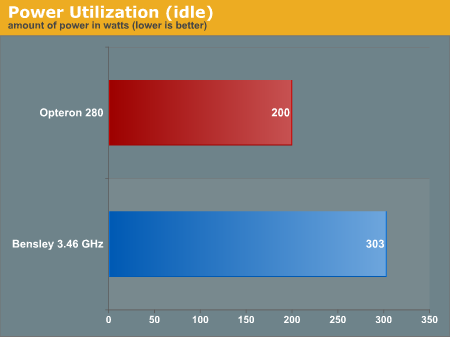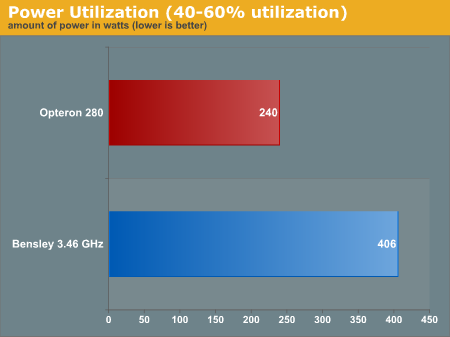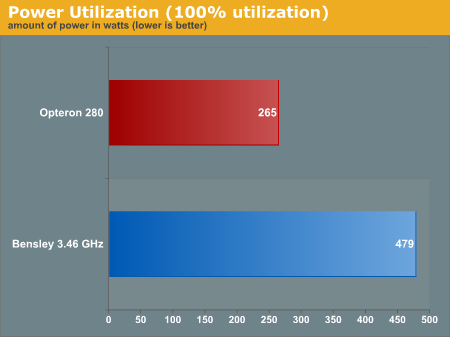Intel’s Dual-Core Xeon First Look
by Jason Clark & Ross Whitehead on December 16, 2005 12:05 AM EST- Posted in
- IT Computing
Power Consumption Results
As we’ve been alluding to throughout this article, power consumption is on the forefront of processor technology now, and into the future. So, starting with this article, we will be including Power Consumption results in future IT articles. It should be no surprise that Opteron dominated these tests, but it probably will be to those who concentrated on performance, and power was of no concern. The Bensley system used approximately 1.5x the amount of power in the idle load test over the Opteron system. Given that a Dempsey (130 W) processor uses approximately 1.4x the amount of power as an Opteron (95 W), the results are inline with the specifications for the two processors.
As the load on the system grew, the Bensley system used 1.7x and 1.8x more power (respective to the 50% and 100% load levels). It’s obvious that the Opteron system is more efficient at higher load levels than the Bensley, thus using less power. The Opteron’s on-die memory controller is one of the factors that would allow the Opteron to be more efficient at higher load levels.
As we’ve been alluding to throughout this article, power consumption is on the forefront of processor technology now, and into the future. So, starting with this article, we will be including Power Consumption results in future IT articles. It should be no surprise that Opteron dominated these tests, but it probably will be to those who concentrated on performance, and power was of no concern. The Bensley system used approximately 1.5x the amount of power in the idle load test over the Opteron system. Given that a Dempsey (130 W) processor uses approximately 1.4x the amount of power as an Opteron (95 W), the results are inline with the specifications for the two processors.
As the load on the system grew, the Bensley system used 1.7x and 1.8x more power (respective to the 50% and 100% load levels). It’s obvious that the Opteron system is more efficient at higher load levels than the Bensley, thus using less power. The Opteron’s on-die memory controller is one of the factors that would allow the Opteron to be more efficient at higher load levels.













67 Comments
View All Comments
Viditor - Friday, December 16, 2005 - link
LOL...good answer! (especially from coldpower)Viditor - Friday, December 16, 2005 - link
BTW...you do know (I assume) that they don't use heaters in a data center, right? (I figured you did, but thought I'd check just to be sure...)JarredWalton - Friday, December 16, 2005 - link
Not entirely true. They use "environmental regulators" that keep humidity and temperature in a set range. In the winter, the AC portion does less, but the fans are still going full blast. I should know, as I'm sitting here listening to the 75 dB hum of a large regulator right now. :|Viditor - Friday, December 16, 2005 - link
That's my world as well...(TV broadcast equipment is kept under the same conditions...) so you have my condolences. But the point I was trying to get across was that the AC never gets turned off when it's a nice day outside...:)
coldpower27 - Friday, December 16, 2005 - link
Finally if we assume 40 Centers for 1 Year.$587.85 for 365.25 Days for 1 Bensley System.
$23,514 Total to Run 40 Systems for 1 Year.
Poser - Friday, December 16, 2005 - link
In addition to the math being off, the assumption that a datacenter would be paying a similar kW/h rate as a residential customer also seems suspicious. As a major customer, they couldn't negotiate a much better rate?coldpower27 - Friday, December 16, 2005 - link
Watt is Joule/Second isn't though??